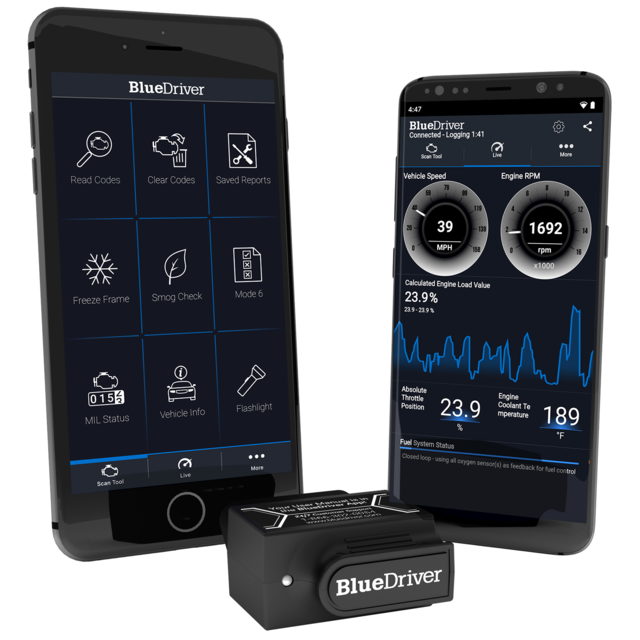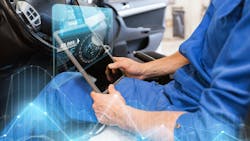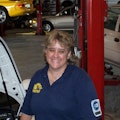The choices we make: Scan tool deals versus embedded technology for collision shop success
We all have that go-to scanner. Sometimes, for a preliminary look, we grab that old familiar tablet. But when it comes to a serious review, the device that works best is the diagnostic tool known to communicate well with that particular year/make/model (YMM). And collision shops are at the forefront of today’s vehicle technology, as accidents have no bias to the age of the vehicle being towed into their shop.
Through the decades, we all have heard, and experienced: “One scanner does not ‘fix’ all cars and trucks.” Technicians know that aftermarket scanning products can have a more-favored brand and play better with one or another manufacturer. Then there are times that we must go straight to the horse’s mouth: either a manufacturer’s scan tool or a laptop with a SAE J2534 pass-through device – that little box between laptop and OBD II connector – for exclusive manufacturer communication. With hundreds of miles of wire attached to approximately 150 modules, today’s collision shop needs to be dead-on accurate from a 1998 Buick LeSabre to the 2023 Ioniq 5 reconstruction job sitting in the next bay.
There are big profits to be made. And one-and-done diagnostics are key to stay on top of this of unique repair industry that boasted $187 billion in receipts last year, according to Broadly Marketing Research — and in 2023, a first-quarter compound annual growth rate (CAGR) up almost two percent among the more than 40,000 U.S. shops. For those techs with the repair ticket — after the electrical/visual inspection -- it’s time for them to plug in and talk to the car or truck. And it’s at that point where many technicians have issues if they are using an underdeveloped tool.
There are two types of collision repair shops and two schools of thought when it comes to purchasing collision repair diagnostic tools. The corporate-owned facility usually purchases equipment — from racks to diagnostic tools — in bulk. That makes sense. Their accountants are more than happy to pay an invoice with a discounted amount based on wholesale purchasing. The mom-and-pop shops don’t have that convenience to purchase en masse, absorbing costs like shipping, commissions, etc., and paying full-rate. Therefore, their automotive tool choices are based on their experience and what they perceive is the best purchase for their buck.
This mode is complicated by the ever-so-comfortable mindset of, “I’ve always used ‘brand X’ scanner.” Our bias of brands – what we prefer to drive, tools we use and training we attend – has spilled over to what we plug into the OBD-II receptacle for decades. But recently, that school of thought has been muddied with the advent of advanced driver assist (ADAS) tools teaming up with companies known for their aligners and racks. The preconception of “who has the best scanner” mold is in question for the moment due to these partnerships.
Partiality set aside, a connectivity choice is not to be taken lightly. The equipment needed to properly and safely repair today’s cars and light trucks needs to be more than a glorified “code-reader.” With hundreds of miles of wire attached to approximately 150 modules in any one of today’s models, a mom-and-pop shop cannot afford diagnostic errors in the bay due to outdated or incorrect application tablets.
This diagnostic-specific side of the tool industry is expanding at a substantial rate. According to a 2023 Globe Newswire report, the $38.2 billion market is expected to grow at a CAGR of 7.1-percent by 2032 – to $75.1 billion in sales. And like we mentioned earlier, the automotive professional needs more than one brand of unit to shake hands with every car and truck they are working on in the bay.
So, when a customer drives – or tows – his or her vehicle to a corporate, dealership or independent shop for body repair, he or she is not looking at what type of equipment the facility has in place to do the job. Approximately 23-percent of the focus (according to a 2021 Fixed Ops Journal report,) is convenience and assuming the facility has the correct tools for the fix. Another mode the customer reviews is the online comments and warranty categories. Shop certifications (state, local and industry) crash-in at a distant fourth, customer choice category. Availability of proper tools came second to last place. But the repair professionals know the importance of qualified equipment is top spot. And scanners rule them all.
Collision repair shop scanner use is well above general, mechanical repair facility practice. Cosmetic reconstruction is secondary as if a technician can’t solve the electromechanical issues caused by the crash; “looking pretty” and not being able to function properly just doesn’t cut it for the customer. Techs need to talk with the car or truck, and the scanner is the industry’s Rosetta Stone.
A collision repair shop’s scanner experience
Automotive professional Frank Felzmann, second-generation owner of Precision Auto Repair, Inc., has been performing mechanical and body repairs for more than five decades – as his father did before him – in his family’s five-bay, Framingham, Massachusetts, location. Just as his multigenerational clientele trusts his work, he has years of experience and trusts in his tool choices.
Felzmann said that his scanner purchases have been based on the recommendation of dependable tool truck company reps. He reflected back on his first scanner purchase – a Snap-on which technicians affectionally called “the brick,” in 1996.
“The first scanner you ever held in your hands and to be able to look digitally at what the car was doing – you know without looking at [bulky] test equipment – was great,” Felzmann reflecting on the new piece of technology in his shop last century.
“When we started buying them [scanners], you know, we thought it would be a lifetime investment,” Felzmann said. “Then, they [manufacturers] stopped supporting them and you had to buy the next thing and realized that the power that the original scanner had was insufficient. It was good enough for its age but not as good as what it needed to be, and it became a boat anchor.”
So, when it comes to eyeing new diagnostic equipment, Felzmann is hesitant to purchase. His pending retirement in a few years weighs heavily on the choice to purchase or not.
“I look at how many vehicle management repairs versus other repairs…to make an investment of a couple grand to $3,500, you think about how long it’s going to take for return on investment," he said. "And I am old enough where I’ve actually done things with meters and voltage tests and stuff so long as you have the information. But it can be difficult to catch an intermittent or glitch.”
Restoration shops need scanners, too
At The Rod Shoppe, in Hudson, Florida, Owner Cody Kemp goes beyond the handheld scanner and heads straight to the laptop with his vehicle communication mode when it comes to customizing engine swaps and modifications.
“You know, they (cars/trucks) have a lot more electronics than ever before. I do need a scanner at the shop, and that’s why I use my HPTuners scan tool on factory-style stuff,” Kemp said.
His automotive career didn’t start off by modifying vehicles. Years earlier, Kemp was an automotive technician at a local dealership. And when it came to talking with the vehicles he was assigned, access was always available via the manufacturer’s dedicated scan tool. For additional communication skills for other vehicle brands that may have found their way into his bay, he purchased a Matco/Launch scanner.
“The small guy – the independent shop – I couldn’t image the money you would have in scanners and all,” he said. “It’s ridiculous!”
And for most, subscription pricing is secondary versus the power and flexibility of what a diagnostic tool can do to up shop production. But when the annual update billing makes its way to your email box, the reality of what it costs to do business sets in. Some annual subscriptions can easily surpass $1,000 per unit. (Smelling salts are extra.) Others’ scan tool annuals can be found at discounted rates via equipment and/or parts websites who sell that brand. It’s worth it to take the time and shop; see who has the best renewal pricing.
And we can’t forget about the new player on the collision team: advanced driver assistance systems (ADAS). This pre-autonomous technology can take a big bite out of the independent collision shop’s budget, costing more than $50,000 (combined ADAS and aligner unit) in some cases. And the body shop doesn’t have a choice. If a vehicle in for repair requires this Level 2 reset -- per manufacturers specs -- there’s no option. The calibration/recalibration must be checked (pre-scan), performed, and verified (post-scan) before the car or truck is returned to the owner. Instead of farming out these services to the local dealership, there are a few independent collision shops who have teamed up with mom-and-pop mechanical repair facilities and split the service jobs into two economically digestible diagnostic equipment pieces. Usually, the mechanical repair facility performs the alignment while the collision shop executes the calibration/recalibration of the ADAS platform.
There are ways of getting the best technology for your buck. And counting pennies to increase your KPI dollar is great. But there are some collision shops that over-count those copper-to-zinc pieces causing shortages in operating monies, cutting back where they should be reinvesting, updating diagnostic equipment. To make up for the deficit, don’t go discount and purchase an underachieving scanner to save a little green. It’s an overall bad choice as more and more vehicles will be showing up at their storefront embedded with ADAS functions that need to be addressed before the vehicle is returned to the customer.
Researching before your next scanner purchase — or combined product like ADAS-aligner — is a must. Run the tickets to review your customer base needs – and if your shop’s KPI can handle the extra burden at this time. Customers might be looking for convenience, but they are listening to what their neighbors, friends, and the online social media buzz as to say about your shop. If you can’t keep up with their vehicle equipment demands, you may want to reevaluate your collision shop’s standards and make the business bookkeeping repair priority-one before the customer drives that extra mile to your competitor.
Some popular scan tool brands
Here are a few of the more popular brands highlighted, suited for the independent body shop:
- ADASLink – This Hunter Engineering – the same people who have been producing aligners for decades – unit is a full-ADAS, diagnostic scanner that ties into their wheel alignment system. When it comes to static (target) calibration/recalibration, the company’s co-partner Bosch is in-tune with this sensor-fusion, multi-company mode.
- ADAS Opti-Aim – Based in Massachusetts, this company shows scanner capabilities for most foreign and domestic cars and light trucks; customized ADAS target packages. And something unique: They have a clearance corner where they sell sales reps’ demos and trade show diagnostic equipment (aftermarket and OEM).
- AirPro Diagnostics – “The Auggie” is a forward-facing camera calibration/recalibration only unit. It’s made to work in tandem with your existing “calibration-capable” scan tool. The company is focused on windshield technicians and body shops.
- Autel - A heavy contender on the ADAS equipment platform, this company has mobile and complete calibration/recalibrations, diagnostics, and an aligner combo.
- Bosch - This centuries-old technology company has teamed up with Hunter Engineering for aligner-ADAS calibration/recalibration and diagnostic equipment.
- Launch Tech – A company that has been around for a long time, it offers calibration/recalibration equipment for both the professional and DIYer.
- Repairify – Combines virtually all aspects of automotive technologies to assist independent shops with workflow development, analytics and repair strategies designed to increase profits and customer count.
- Snap-on – Most of us remember the “brick” and its subsequent morph into more sophisticated units though the decades. Now, the company is showing off its ADAS capabilities (targets and stand available at additional cost); the ADAS system has targets for most year/make/model vehicles for static calibration/recalibration functions as well as dynamic functions.
- Texa – This international company develops different types of diagnostic scanners, gas analyzers, HVAC stations. These tools are designed specifically for foreign and domestic cars, light trucks.
- Thinkcar – Diagnostic and ADAS tools for cars, light trucks, HD trucks, electrified vehicles for collision and repair shops.
- Topdon – A popular product that has a very visible presence at most automotive training trade shows, recently. Their scanners have ADAS (targets and stand available at additional cost) and coding capabilities for foreign and domestic cars and light trucks.
Popular choices for the initial scan
Body shops love to use "quick-check” scanners/tablets for the rapid, initial scan. These units are not intended for a deep-dive diagnostic investigation:
- BlueDriver – This dongle-to-smartphone set-up appears most often amongst sites sharing their shop equipment poll. The unit is more for the DIYer, but this generic device can be used for a quick-preliminary communication review. Mode $06 and live data are available buttons on this program, as well.

- EScan — Diagnostic software for your shop laptop that’s easy to use. Includes oscilloscope, gas analyzer, borescope, pressure analysis options, noise and vibration are other add-ons, as well. (No ADAS support, currently.)
About the Author
Pam Oakes
Automotive SME Pam Oakes has been embedded within the automotive industry for 30 years as an automotive applications engineer, instructor/course developer (for several international companies), 609 instructor/test proctor, automotive business expert/strategist, 20-year original start-up shop owner/multiple auto business owner, ASE master automotive and medium/HD truck and collision technician-trainer with L4 ADAS, diesel Class 8 instructor, ASE testing contributing panel member (L4/A7), automotive author, syndicated radio host, and automotive-consumer news media commentator. And she still “turns-wrenches” for fun.

